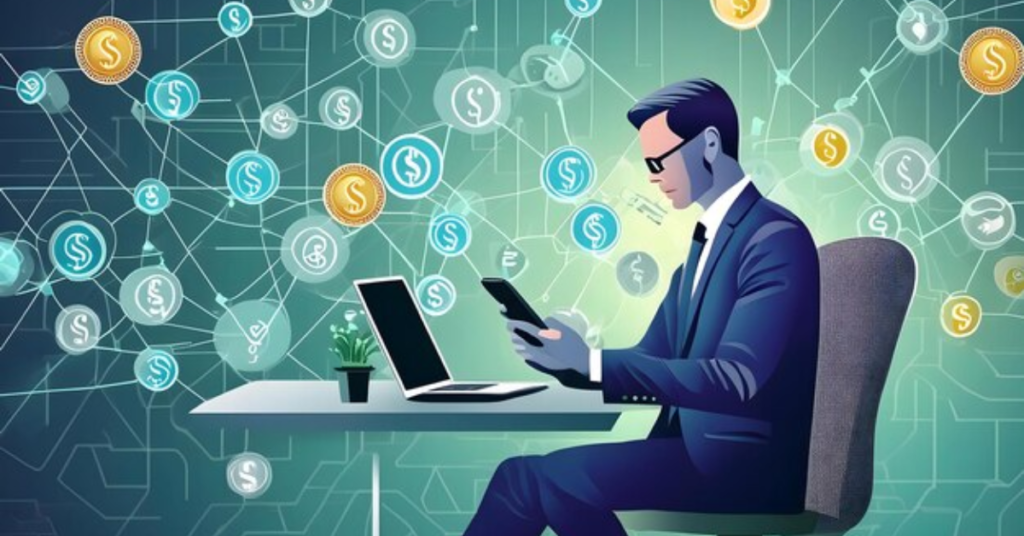The world of finance has undergone a radical transformation in recent years, driven by technological advancements that have reshaped how people manage their money. Among the many innovations in this space, TraceLoans stands out as a revolutionary concept that is changing the way individuals and businesses borrow money. Unlike traditional loans, which often involve lengthy processes and significant paperwork, TraceLoans leverage cutting-edge technology to offer a more streamlined, secure, and accessible borrowing experience. This article delves into the world of TraceLoans, exploring how they work, what sets them apart from conventional loans, and why they represent the future of borrowing.
What Are TraceLoans?
TraceLoans are a new breed of loans that utilize advanced technologies like blockchain, artificial intelligence (AI), and big data analytics to offer a more efficient and transparent lending process. Unlike traditional loans, which rely on centralized financial institutions to approve and manage the borrowing process, TraceLoans operate on decentralized platforms. This means that the loan approval, disbursement, and repayment processes are all managed through secure, automated systems, reducing the need for intermediaries and making the entire process faster and more cost-effective.
Key Features of TraceLoans
- Decentralization: TraceLoans are typically offered through decentralized finance (DeFi) platforms, which operate without the need for traditional banks or financial institutions. This decentralization allows for greater transparency, as all transactions are recorded on a public ledger (blockchain), which can be accessed by all parties involved.
- Smart Contracts: At the heart of TraceLoans are smart contracts, which are self-executing contracts with the terms of the agreement directly written into code. These smart contracts automatically enforce the loan agreement, ensuring that funds are disbursed, repayments are made, and penalties are applied without the need for manual intervention.
- AI-Powered Risk Assessment: One of the most significant advantages of TraceLoans is the use of AI and machine learning algorithms to assess the creditworthiness of borrowers. These technologies analyze vast amounts of data, including financial history, spending patterns, and even social media activity, to determine a borrower’s risk profile. This allows for more accurate and personalized loan offers, often at lower interest rates than traditional loans.
- Blockchain Security: TraceLoans benefit from the inherent security features of blockchain technology. All transactions are encrypted and recorded on a decentralized ledger, making it virtually impossible for unauthorized parties to tamper with the data. This ensures that both borrowers and lenders can trust the integrity of the loan process.
- Speed and Efficiency: The automated nature of TraceLoans means that the approval and disbursement processes are significantly faster than traditional loans. In many cases, borrowers can receive funds within minutes of applying, making TraceLoans an ideal solution for those in need of quick access to capital.
How TraceLoans Differ from Traditional Loans
TraceLoans are fundamentally different from the loans your parents might have used. Traditional loans typically involve a lengthy application process, extensive paperwork, and a waiting period that can stretch from days to weeks. Moreover, traditional loans are often subject to high-interest rates, hidden fees, and rigid repayment terms that can make borrowing an expensive and stressful experience.
In contrast, TraceLoans offer a more flexible, transparent, and borrower-friendly alternative. Here are some of the key differences between TraceLoans and traditional loans:
1. Application Process:
Traditional loans require borrowers to fill out extensive application forms, provide detailed financial documentation, and undergo a credit check. This process can take several days or even weeks. With TraceLoans, the application process is streamlined and digital. Borrowers simply need to provide basic information, and the system uses AI to assess their creditworthiness in real-time.
2. Approval Time:
Traditional loans can take days or weeks to be approved, depending on the lender’s criteria and the complexity of the loan. TraceLoans, on the other hand, are typically approved within minutes, thanks to automated decision-making processes powered by AI and smart contracts.
3. Transparency:
One of the biggest criticisms of traditional loans is the lack of transparency. Borrowers often face hidden fees, unclear terms, and unexpected changes in interest rates. TraceLoans address these issues by offering complete transparency. All terms and conditions are coded into the smart contract, which is publicly accessible on the blockchain. This ensures that borrowers know exactly what they are getting into before they accept the loan.
4. Interest Rates:
Traditional loans often come with high-interest rates, especially for borrowers with less-than-perfect credit scores. TraceLoans, however, use AI to assess risk more accurately, allowing lenders to offer lower interest rates to borrowers who may have been considered high-risk by traditional standards. Additionally, the absence of intermediaries reduces costs, which can further lower interest rates.
5. Repayment Flexibility:
Traditional loans typically come with fixed repayment schedules, which can be challenging for borrowers with irregular income or unexpected expenses. TraceLoans offer more flexible repayment options, allowing borrowers to adjust their payment schedules according to their financial situation. Some platforms even offer dynamic interest rates that adjust based on market conditions, providing additional flexibility.
The Technology Behind TraceLoans
The success of TraceLoans is largely due to the advanced technologies that power them. These technologies not only make the lending process more efficient but also enhance security, transparency, and accessibility. Here’s a closer look at the key technologies behind TraceLoans:
1. Blockchain:
Blockchain is the backbone of TraceLoans. This distributed ledger technology records all transactions in a secure, transparent, and immutable way. Every transaction on the blockchain is encrypted and linked to the previous one, creating a chain of data that cannot be altered. This ensures that all loan-related activities, from application to repayment, are securely documented and accessible to all parties involved.
2. Smart Contracts:
Smart contracts are self-executing contracts that run on blockchain networks. They automatically enforce the terms of a loan agreement, ensuring that payments are made, collateral is released, and penalties are applied without the need for manual intervention. Smart contracts remove the need for intermediaries, such as banks or lawyers, reducing costs and speeding up the loan process.
3. Artificial Intelligence and Machine Learning:
AI and machine learning play a crucial role in TraceLoans by analyzing vast amounts of data to assess the creditworthiness of borrowers. These technologies can process data from various sources, including financial history, employment records, and even social media activity, to create a detailed risk profile for each borrower. This allows for more accurate lending decisions and personalized loan offers that reflect the borrower’s true financial situation.
4. Big Data Analytics:
Big data analytics involves analyzing large and complex datasets to uncover patterns, trends, and insights. In the context of TraceLoans, big data is used to assess market conditions, predict borrower behavior, and optimize lending strategies. By leveraging big data, lenders can make more informed decisions, reduce risks, and offer better loan terms to borrowers.
The Benefits of TraceLoans for Borrowers
TraceLoans offer a range of benefits that make them an attractive option for borrowers, particularly in today’s fast-paced, digital world. Here are some of the key advantages of choosing TraceLoans over traditional loans:
1. Accessibility:
TraceLoans are accessible to a broader range of borrowers, including those who may have been excluded from traditional lending due to poor credit scores or lack of collateral. The use of AI and alternative data sources allows lenders to assess creditworthiness more accurately, opening up lending opportunities to individuals and businesses who may have been overlooked by traditional financial institutions.
2. Speed:
The automated nature of TraceLoans means that borrowers can receive funds much faster than with traditional loans. In many cases, loans are approved and disbursed within minutes, making TraceLoans an ideal solution for emergencies or time-sensitive financial needs.
3. Lower Costs:
By eliminating intermediaries and reducing the need for manual processing, TraceLoans often come with lower fees and interest rates than traditional loans. This makes borrowing more affordable and accessible to a wider range of people.
4. Transparency and Trust:
The use of blockchain technology ensures that all loan terms are transparent and immutable. Borrowers can trust that the terms of their loan will not change unexpectedly, and they can easily access all relevant information through the blockchain. This transparency builds trust between borrowers and lenders, fostering a more positive lending experience.
5. Personalization:
TraceLoans offer a more personalized borrowing experience. The use of AI allows lenders to tailor loan offers to the individual needs and circumstances of each borrower, resulting in more favorable terms and conditions. This personalization extends to repayment options, which can be adjusted to fit the borrower’s financial situation.
The Benefits of TraceLoans for Lenders
TraceLoans also offer significant advantages for lenders, making them an attractive option for those looking to invest in the lending market. Here are some of the key benefits for lenders:
1. Reduced Risk:
The use of AI and big data analytics allows lenders to assess risk more accurately, reducing the likelihood of defaults. By analyzing a wider range of data, lenders can create more accurate risk profiles and make more informed lending decisions.
2. Lower Costs:
By eliminating intermediaries and automating the loan process, TraceLoans reduce operational costs for lenders. This allows lenders to offer more competitive rates to borrowers while still maintaining profitability.
3. Increased Efficiency:
The automated nature of TraceLoans means that lenders can process more loans in less time. This increased efficiency allows lenders to scale their operations and reach a larger market, resulting in higher returns on investment.
4. Transparency and Accountability:
The use of blockchain technology ensures that all loan transactions are transparent and immutable. This transparency builds trust with borrowers and
reduces the risk of disputes or fraud. Additionally, the use of smart contracts ensures that all loan terms are enforced automatically, reducing the need for manual intervention and ensuring that all parties are held accountable.
5. Access to a Broader Market:
The decentralized nature of TraceLoans allows lenders to reach borrowers in underserved markets, including those who may have been excluded from traditional lending due to geographical or financial barriers. This opens up new opportunities for lenders to expand their market reach and diversify their investment portfolios.
Potential Challenges and Considerations
While TraceLoans offer numerous benefits, there are also potential challenges and considerations that borrowers and lenders should be aware of. As with any new technology, there are risks involved, and it’s essential to understand these risks before diving into the world of TraceLoans.
1. Regulatory Uncertainty:
The regulatory environment for TraceLoans is still evolving, and there may be uncertainties regarding how these loans are governed. Borrowers and lenders should be aware of the legal and regulatory landscape in their region and ensure that they are compliant with all relevant laws and regulations.
2. Technology Risks:
While blockchain and AI offer significant advantages, they are not without risks. For example, smart contracts are only as reliable as the code they are written in, and errors in the code could lead to unintended consequences. Additionally, while blockchain is secure, it is not immune to hacking or other forms of cyberattacks.
3. Market Volatility:
The decentralized nature of TraceLoans means that they are often tied to the broader cryptocurrency market, which can be highly volatile. Borrowers and lenders should be aware of the potential for market fluctuations and consider how this may impact their loans.
4. Accessibility and Digital Literacy:
While TraceLoans are designed to be more accessible, they still require a certain level of digital literacy. Borrowers who are not familiar with blockchain or AI may find the process intimidating or confusing. It’s essential for platforms offering TraceLoans to provide clear and accessible resources to help users understand how the process works.
The Future of TraceLoans
As technology continues to evolve, TraceLoans are poised to become an increasingly important part of the global lending landscape. Here are some trends and developments that may shape the future of TraceLoans:
1. Integration with Traditional Finance:
As TraceLoans gain popularity, we may see greater integration with traditional financial institutions. This could involve partnerships between DeFi platforms and banks, or the adoption of blockchain and AI technologies by traditional lenders. Such integration could offer the best of both worlds, combining the efficiency and transparency of TraceLoans with the stability and trust of traditional finance.
2. Increased Adoption in Emerging Markets:
TraceLoans have the potential to revolutionize lending in emerging markets, where access to traditional financial services is often limited. By offering a more accessible and affordable alternative, TraceLoans could help bridge the financial inclusion gap and provide new opportunities for individuals and businesses in these regions.
3. Continued Innovation:
The world of TraceLoans is still in its early stages, and we can expect continued innovation in this space. This may include the development of new lending models, the use of alternative data sources for credit assessment, and the introduction of new technologies that enhance the lending process even further.
4. Focus on Sustainability and Social Impact:
As the financial industry becomes more focused on sustainability and social impact, TraceLoans could play a role in promoting responsible lending practices. This could involve the use of blockchain to ensure that loans are used for socially or environmentally beneficial purposes, or the development of lending platforms that prioritize underserved communities.
Conclusion
TraceLoans represent a significant shift in the way we think about borrowing money. By leveraging advanced technologies like blockchain, AI, and smart contracts, TraceLoans offer a more efficient, transparent, and accessible alternative to traditional loans. Whether you’re a borrower looking for a more personalized lending experience, or a lender seeking to reduce risk and increase efficiency, TraceLoans offer a range of benefits that make them an attractive option in today’s digital age.
As we look to the future, TraceLoans are likely to play an increasingly important role in the global financial system. With continued innovation, greater integration with traditional finance, and a focus on sustainability and social impact, TraceLoans have the potential to revolutionize lending and create new opportunities for individuals and businesses around the world. Whether you’re already familiar with TraceLoans or just starting to explore this exciting new technology, now is the time to learn more about how they can benefit you and your financial goals.







